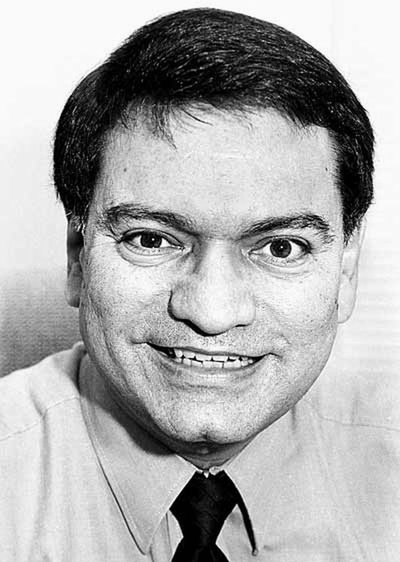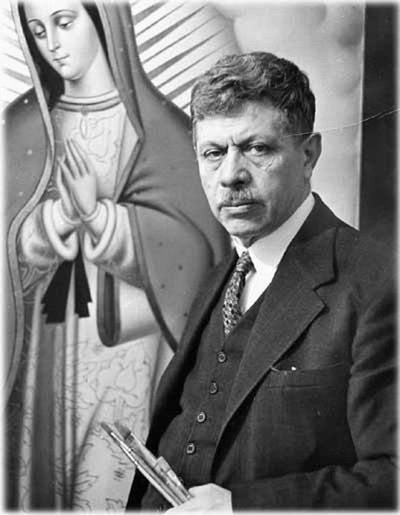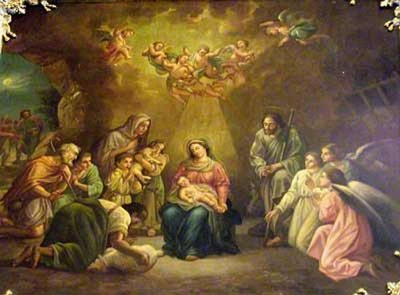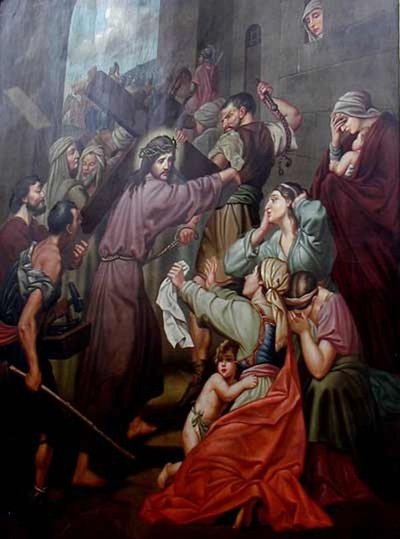November 29, 2001
A Mexican master: Retracing the footsteps of a talented grandfather
For most people, researching family history involves looking at old photographs in attics. For UW staffer Eugene Magallanes, the pictorial artifacts are a little larger – like, say, 6 by 8 feet – and found everywhere from churches to galleries to convents. That happens when the grandfather whose life you’re researching was an artist – an artist who worked on commissions throughout the central states of Mexico and later, the United States.
“I never knew my grandfather; I was very young when he died,” explains Magallanes, the director of the Minority Science and Engineering Program. “But I always heard stories about him, about how he was a well-known artist in Mexico.”
The family owned a few of his paintings, Magallanes says, and from time to time as he was growing up in Los Angeles he would be taken to particular sites and shown other pieces. But he always wondered about those other paintings, the big ones back in Mexico that he had heard about but never seen.
Who could blame him for being curious, given the stories about grandpa, whose name was Candelario Rivas? There was the story about how, as a 12-year-old, Rivas ran off with the circus because he was impressed with the large circus paintings and wanted to learn how to use colors that way. Then there was the story of how he was called in secretly to restore the image of Our Lady of Guadalupe after the basilica in which it resided was bombed. Perhaps most exciting to a child’s imagination, however, was the story of Rivas and General Pancho Villa.
As Magallanes tells it, some of Villa’s soldiers appeared at the Rivas home one day in 1914 and told the painter that he would be coming along with them to paint the portrait of Villa and his family. As he was marched away, his wife feared she would never see him again. “He didn’t exactly have a gun held to his head, but everybody knew he’d better do a good job or he wouldn’t be painting much longer,” Magallanes says.
Rivas completed the job in three days and returned home, only to be summoned again a few days later. Senora Villa didn’t like the way he had done her eyebrows, he was told. He would have to fix this problem. Apparently he did so satisfactorily, because he lived to tell about it.
Magallanes was understandably fascinated with this grandfather, as were his first cousins. For years they talked about trying to locate and photograph Rivas’ artwork, but they never got around to it. Magallanes was taught to paint by Rivas’ daughter – his Aunt Carmen, also an artist – but decided on engineering as his day job. Years passed, and then technology stepped in.
“Digital cameras became powerful and affordable, and I saw a way we’d be able to do this,” Magallanes says.
“This” turned out to be a book – a loose-leaf notebook, actually – containing some text about Rivas’ life, some family photographs and printouts of digital images of the artist’s paintings. Following leads from family stories, Magallanes and some of his cousins traveled to Mexico and around the U.S., looking for the artwork. They started with 15 paintings and wound up with 96.
Much of what they found in Mexico was in churches. In those days, Magallanes explains, it was routine for the Catholic Church to commission large murals and other artworks to adorn their houses of worship. Rivas would work for several years sometimes, executing large paintings on religious subjects. His first such commission, in fact, came when he was only 17, and was well enough received that he was able to make a very good living this way until he was 45. At that point, in 1923, the violence in Mexico forced him to leave the country and settle in L.A.
His departure was the source of another exciting story. It seems that as church officials fled the country, the government was seizing artwork from churches and selling it to support their cause. Rivas went secretly to one church where his murals hung and cut them down, rolled them up inside a pipe and buried them in a cemetery. Later, a trusted friend smuggled them out of Mexico, but Rivas never exhibited them again, fearing he would be accused of stealing Mexican national treasures. The murals were later destroyed in a house fire.
Rivas’ life in California was considerably different as he learned that American churches rarely hired artists to do original work. But he managed by doing portraits and even worked for Hollywood studios for a time. He painted the castle of the Wicked Witch of the West that appears in The Wizard of Oz. He continued to do religious paintings when he could, but the commissions were rarely as large as those in Mexico.
“When my cousins and I got to Mexico, we were astonished at the magnificent murals we found there, and we discovered that my grandfather was something of a legend in the area,” Magallanes says. “While we were there we were interviewed by the newspapers as the descendants of Candelario Rivas.”
Along with the triumphs came disappointments, of course. Buildings housing artworks had been destroyed in earthquakes or fires; some paintings had been stolen. “We weren’t able to locate the Pancho Villa painting,” Magallanes says, “but we were able to get documentation from several sources that that really happened. And we have some leads on where we can find it when we go back.”
Going back is definitely in the cards. Magallanes and his cousins plan another trip in the spring, and will probably never stop looking for their grandfather’s work. For that reason the “book” will never be finished. It’s not a book for sale, Magallanes explains. He was allowed to photograph the work on the condition that he not sell the images.
“This wasn’t about making money anyway,” he says “What we wanted to do was to preserve the family heritage for our children and grandchildren.”
Magallanes will be doing a power point presentation about his grandfather’s artwork at noon on Tuesday, Dec. 11 in 355 Loew.




